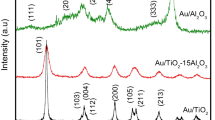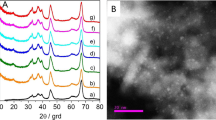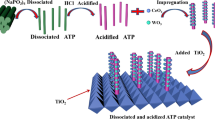Abstract
SnO2 nanoparticles were prepared using the hydrothermal method. The particle size was gradually increased with increasing the hydrothermal temperature and period. The size of SnO2 nanoparticles was successfully controlled in the range of 2.3–5.9 nm. The deposition of SnO2 nanoparticles on to Al2O3 was made through impregnation process. TEM and XRD measurements revealed that SnO2 nanoparticles are highly dispersed on the surface of Al2O3 without changing the particle size. When SnO2 nanoparticles prepared at 150 °C for 3 h were deposited on to Al2O3 (denoted as SnO2-150-3/Al2O3), a part of SnO2 nanoparticles was suspected to be dispersed inside of the pores of Al2O3. This is probably due to a small size of SnO2 nanoparticles compared with the pore diameter of Al2O3. On the other hand, SnO2 nanoparticles with relatively large size were found to be predominantly present on the outer surface of Al2O3. H2-TPR measurements suggest the presence of SnO2–Al2O3 interaction in SnO2/Al2O3 catalysts. Especially, SnO2-150-3/Al2O3 was considered to include SnO2 nanoparticles interacting more strongly with Al2O3. SnO2/Al2O3 catalysts showed higher catalytic activity for the selective reduction of NO with C3H6 than Al2O3, suggesting that the SnO2/Al2O3 prepared using SnO2 nanoparticles is effective to develop highly active catalyst.







Similar content being viewed by others
References
Lucky SS, Soo KC, Zhang Y (2015) Nanoparticles in photodynamic therapy. Chem Rev 115:1990–2042
Irvine DJ, Hanson MC, Rakhra K, Tokatlian T (2015) Synthetic nanoparticles for vaccines and immunotherapy. Chem Rev 115:11109–11146
Thanh NTK, Maclean N, Mahiddine S (2014) Mechanisms of nucleation and growth of nanoparticles in solution. Chem Rev 114:7610–7630
Duan H, Wang D, Li Y (2015) Green chemistry for nanoparticles synthesis. Chem Soc Rev 44:5778–5792
Hussain I, Graham S, Wang Z, Tan B, Sherrington DC, Rannard SP, Cooper AI, Brust M (2005) Size-controlled synthesis of near-monodisperse gold nanoparticles in the 1–4 nm range using polymeric stabilizers. J Am Chem Soc 127:16398–16399
Teranishi T, Miyake M (1998) Size control of palladium nanoparticles and their crystal structures. Chem Mater 10:594–600
Watanabe R, Ishizaki T (2013) Size- and shape-controlled synthesis of colloidal Sn, Te, and Bi nanocrystals. Bull Chem Soc Jpn 86:642–650
Tian N, Zhou ZY, Sun SG, Ding Y, Wang ZL (2007) Synthesis of tetrahexahedral platinum nanocrystals with high-index facets and high electro-oxidation activity. Science 316:732–735
Salavati-Niasari M, Davar F, Mir N (2008) Synthesis and characterization of metallic copper nanoparticles via thermal decomposition. Polyhedron 27:3514–3518
Panáček A, Kvitek L, Pureck R, Kolář M, Večeřová R, Pizúrová N, Sharma VK, Nevĕčná T, Zbořil R (2006) Silver colloid nanoparticles: synthesis, characterization, and their antibacterial activity. J Phys Chem B 110:16248–16253
Zhou HS, Honma I, Komiyama H, Haus JW (1994) Controlled synthesis and quantum-size effect in gold-coated nanoparticles. Phys Rev B 50:12052–12056
Imagawa H, Suda A, Yamaura K, Sun S (2011) Monodisperse CeO2 nanoparticles and their oxygen storage and release properties. J Phys Chem C 115:1740–1745
Taniguchi T, Watanabe T, Sakamoto N, Matsushita N, Yoshimura M (2008) Aqueous route to size-controlled and doped organophilic ceria nanocrystals. Cryst Growth Des 8:3725–3730
Kobayashi K, Haneda M, Ozawa M (2012) Hydrothermal synthesis of CeO2 nanocrystals using oleate-modified precipitation method. Adv Mater Res 463–464:1501–1505
Tanimoto K, Kato H, Hidaka H, Hinokuma S, Ikeue K, Machida M (2013) Nanometric colloidal sols of CeO2-ZrO2 solid solution as catalyst modifiers. I. preparation and structure. Bull Chem Soc Jpn 86:1210–1215
Chen Z, Pan D, Li Z, Jiao Z, Wu M, Shek C-H, Wu CML, Lai JKL (2014) Recent advances in tin dioxide materials: some developments in thin films, nanowires and nanorods. Chem Rev 114:7442–7486
Chen W, Ghosh D, Chen S (2008) Large-scale electrochemical synthesis of SnO2 nanoparticles. J Mater Sci 43:5291–5299. doi:10.1007/s10853-008-2792-x
Baik NS, Sakai G, Miura N, Yamazoe N (2000) Preparation of stabilized nanosized tin oxide particles by hydrothermal treatment. J Am Ceram Soc 83:2983–2987
Chiu H-C, Yeh C-S (2007) Hydrothermal synthesis of SnO2 nanoparticles and their gas-sensing of alcohol. J Phys Chem C 111:7256–7259
Adnan R, Razana NA, Rahman IA, Farrukh MA (2010) Synthesis and characterization of high surface area tin oxide nanoparticles via the sol-gel method as a catalyst for the hydrogenation of styrene. J Chin Chem Soc 57:222–229
Moghdam MB, Zebarjad SM, Emampour JS, Youssefi A (2013) A study on the role of ethylene glycol/alcohol ratio on synthesis of nano-size SnO2. Particul Sci Technol 31:66–70
Jiang J, Sun G, Zhou Z, Sun S, Wang Q, Yan S, Li H, Tian J, Guo J, Zhou B, Xin Q (2005) Size-controllable synthesis of monodispersed SnO2 nanoparticles and application in electrocatalysts. J Phys Chem B 109:8774–8779
Jitianu A, Altindag Y, Zaharescu M, Wark M (2003) New SnO2 nano-clusters obtained by sol-gel route, structural characterization and their gas sensing applications. J Sol-Gel Sci Technol 26:483–488
Lan F, Wang X, Xu X, Zhang R, Zhang N (2012) Preparation and characterization of SnO2 catalysts for CO and CH4 oxidation. React Kinet Mech Catal 106:113–125
Mizuhata M, Umegaki Y, Nakata A, Kumaresan R, Deki S (2009) Room-temperature synthesis of monodispersed SnO2 nanoparticles by liquid phase deposition. Chem Lett 38:974–975
Haneda M, Ohzu S, Kintaichi Y, Shimizu K, Shibata J, Yoshida H, Hamada H (2001) Sol-gel prepared Sn-Al2O3 catalysts for the selective reduction of NO with propene. Bull Chem Soc Jpn 74:2075–2081
Tabata M, Hamada H, Suganuma F, Yoshinari T, Tsuchida H, Kintaichi Y, Sasaki M, Ito T (1994) Promotive effect of Sn on the catalytic activity of Al2O3 for the selective reduction of NO by methanol. Catal Lett 25:55–60
Kung MC, Park PW, Kim D-W, Kung HH (1999) Lean NOx catalysis over Sn/γ-Al2O3 catalysts. J Catal 181:1–5
Park PW, Kung HH, Kim D-W, Kung MC (1999) Characterization of SnO2/Al2O3 lean NO x catalysts. J Catal 184:440–454
Liu Z, Li J, Hao J (2010) Selective catalytic reduction of NOx with propene over SnO2/Al2O3 catalyst. Chem Eng J 165:420–425
Fujihara S, Maeda T, Ohgi H, Hosono E, Imai H, Kim S-H (2004) Hydrothermal routes to prepare nanocrystalline mesoporous SnO2 having high thermal stability. Langmuir 20:6476–6481
Saikala R, Gupta NM, Kulshreshtha SK (2001) Temperature-programmed reduction and CO oxidation studies over Ce-Sn mixed oxides. Catal Lett 71:69–73
Lieske H, Völter J (1984) State of tin in Pt-Sn/Al2O3 reforming catalysts investigated by TPR and chemisorption. J Catal 90:96–105
Auroux A, Sprinceana D, Gervasini A (2000) Support effects on de-NO x catalytic properties of supported tin oxides. J Catal 195:140–150
Fabritchnyl PB, Sudakova NR, Berentsveig VV, Demazeau G, Afanasov MI, Etourneau J (1992) Modifying action of Sn4+ ions located at the surface of a Cr2O3 catalyst investigated by means of Mössbauer spectroscopy. J Mater Sci 2:763–764. doi:10.1039/JM9920200763
Wang X, Xie Y-C (2001) Total oxidation of CH4 on Sn-Cr composite oxide catalysts. Appl Catal B 35:85–94
Xu X, Zhang R, Zeng X, Han X, Li Y, Liu Y, Wang X (2013) Effect of La, Ce, and Y oxides on SnO2 catalysts for CO and CH4 oxidation. ChemCatChem 5:2025–2036
Xu X, Sun X, Han H, Peng H, Liu W, Peng X, Wang X, Yang X (2015) Improving water tolerance of Co3O4 by SnO2 addition for CO oxidation. Appl Surf Sci 355:1254–1260
Burch R (2004) Knowledge and know-how in emission control for mobile applications. Catal Rev 46:271–333
Hamada H (1994) Selective reduction of NO by hydrocarbons and oxygenated hydrocarbons over metal oxide catalysts. Catal Today 22:21–40
Shimizu K, Satsuma A, Hattori T (2000) Metal oxide catalysts for selective reduction of NO x by hydrocarbons: toward molecular basis for catalyst design. Catal Surv Jpn 4:115–123
Kung MC, Kung HH (2004) Selective lean NO x reduction over metal oxides. Top Catal 28:105–110
Liu Z, Woo SI (2006) Recent advances in catalytic DeNO x science and technology. Catal Rev 48:43–89
Teraoka Y, Harada T, Iwasaki T, Ikeda T, Kagawa S (1993) Selective reduction of nitrogen monoxide with hydrocarbons over SnO2 catalyst. Chem Lett 22:773–776
Hamada H (1997) Cooperation of catalytic species for the selective reduction of nitrogen monoxide with hydrocarbons. Catal Surv Jpn 1:53–60
Liu Z, Woo SI, Lee WS (2006) In situ FT-IR studies on the mechanism of selective reduction of NO x by propene over SnO2/Al2O3 catalyst. J Phys Chem B 110:26019–26023
Li J, Hao J, Fu L, Liu Z, Cui X (2004) The activity and characterization of sol-gel Sn/Al2O3 catalyst for selective catalytic reduction of NO x in the presence of oxygen. Catal Today 90:215–221
Liu Z, Hao J, Fu L, Zhu T, Li J, Cui X (2003) Promoting effect of sol-gel method and pretreatment on the activity of SnO2/Al2O3 catalyst for NO reduction by propene. React Kinet Catal Lett 80:45–52
Author information
Authors and Affiliations
Corresponding author
Ethics declarations
Conflict of interest
The authors declare that they have no conflict of interest.
Rights and permissions
About this article
Cite this article
Haneda, M., Ota, Y., Doi, Y. et al. Preparation, characterization, and activity of SnO2 nanoparticles supported on Al2O3 as a catalyst for the selective reduction of NO with C3H6 . J Mater Sci 51, 10949–10959 (2016). https://doi.org/10.1007/s10853-016-0307-8
Received:
Accepted:
Published:
Issue Date:
DOI: https://doi.org/10.1007/s10853-016-0307-8




